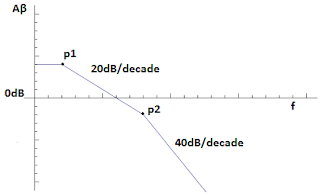Fermi Level
The Fermi Level is the equilibrium electrochemical potential. It represents the expected value of the change in energy of one electron added to (or taken from) the system. For any state with Energy E, the probability of occupation for that state is given by the Fermi-Dirac distribution:
$$ f_{FD}(E)=\frac{1}{1+exp\left ( \frac{E-E_{f}}{kT} \right )} $$
The Fermi level represents the boundary between the mostly filled and mostly empty states in equilibrium, with temperature determining how sharp that boundary is. Far above or below the Fermi level, the Fermi-Dirac distribution can be approximated by the Boltzmann distribution:
$$ f_{FD}(E)\cong \begin{cases}
exp(E-\frac{E_{f}}{kT}) & \text{, if } E>E_{f}+3kT \\
1-exp(E_{f}-\frac{E}{kT}) & \text{, if } E<E_{f}-3kT
\end{cases} $$
exp(E-\frac{E_{f}}{kT}) & \text{, if } E>E_{f}+3kT \\
1-exp(E_{f}-\frac{E}{kT}) & \text{, if } E<E_{f}-3kT
\end{cases} $$
To calculate the relation between Fermi level and carrier concentration, it is necessary to specify the density of states in the conduction (or valence) band. For a single parabolic conduction band with:
$$ E=E_{c}+ \frac{\hbar^2k_{x}^{2}}{2m_{x}^{*}}+\frac{\hbar^2k_{y}^{2}}{2m_{y}^{*}}+\frac{\hbar^2k_{z}^{2}}{2m_{z}^{*}} $$ the density of states is:
$$ N(E)=\frac{\sqrt{m_{z}^{*}m_{y}^{*}m_{x}^{*}}}{2\pi^{2}}\left ( \frac{2}{\hbar} \right )^{3/2} \sqrt{E-E_{c}} $$
For a semiconductor with multiple band externa (for example Si with 6 equivalent conduction band minima and 2 nonequivalent valence band maxima), the density of states for all the bands must be added together. The result is:
$$ N(E)=\frac{1}{2\pi^{2}}\left ( \frac{2m_{dn}}{\hbar} \right )^{3/2}\sqrt{E-E_{c}} $$, where mdn is the density-of-states effective mass for the conduction band.
The number of electrons in the conduction band is given by integrating the Fermi-Dirac distribution times the density of states over energy.
$$ n=\int_{0}^{\infty }f_{FD}(E)N(E)dE = N_{c}F_{1/2}\left ( \frac{E_{f}-E_{c}}{kT} \right ) $$, where $$ N_{c}=2\left ( \frac{m_{dn}kT}{2\pi \hbar^{2}} \right ),\; \; \; F_{n}(\eta )=\frac{2}{\sqrt{\pi}}\int_{0}^{\infty }\frac{x^{n}dn}{1+exp(x-\eta )} $$
Similarly for the valence band,
$$ p=\int_{0}^{\infty }f_{FD}(E)N(E)dE = N_{v}F_{1/2}\left ( \frac{E_{v}-E_{f}}{kT} \right ) $$
Equilibrium electrochemical potential:
The number of electrons in the conduction band is given by integrating the Fermi-Dirac distribution times the density of states over energy.
$$ n=\int_{0}^{\infty }f_{FD}(E)N(E)dE = N_{c}F_{1/2}\left ( \frac{E_{f}-E_{c}}{kT} \right ) $$, where $$ N_{c}=2\left ( \frac{m_{dn}kT}{2\pi \hbar^{2}} \right ),\; \; \; F_{n}(\eta )=\frac{2}{\sqrt{\pi}}\int_{0}^{\infty }\frac{x^{n}dn}{1+exp(x-\eta )} $$
Similarly for the valence band,
$$ p=\int_{0}^{\infty }f_{FD}(E)N(E)dE = N_{v}F_{1/2}\left ( \frac{E_{v}-E_{f}}{kT} \right ) $$
Equilibrium electrochemical potential:
Considering a non-degenerate material for simplicity, the Fermi level can be written in terms of the electron concentration:
$$ E_{f}=E_{c}+kTln\left ( \frac{n}{N_{c}} \right )=E_{i}+kTln\left ( \frac{n}{n_{i}} \right ) $$
The electric field is defined as the negative gradient of the electrical potential ψ, but it can also be expressed in termos of the gradient in the conduction or valence band (no change in bandgap).
$$ \varepsilon\equiv -\frac{d\psi }{dx}=\frac{1}{q}\frac{dE_{c}}{dx}=\frac{1}{q}\frac{dE_{v}}{dx}=\frac{1}{q}\frac{dE_{i}}{dx} $$
If we apply these equations plus the Einstein relations (μn/q=Dn/kT) to the electron current equation, it is possible to show that:
$$ J_{n}=n\mu_{n}\frac{dE_{f}}{dx} $$
Thus in equilibrium, Jn = 0, Ef = constant. Another way to think about this fact is that if there was a change in electron potential with position, electrons could move around to reduce the energy of the system.
Quasi-Fermi Levels
Under thermal equilibrium, we use the equations relation the Fermi level to the electron and hole concentrations. For example,
$$ n=n_{i}exp\left ( \frac{E_{f}-E_{i}}{kT} \right ) $$
However, if we have injection (np>ni2) or extraction (np<ni2), then we are not in equilibrium and therefore cannot use these relationships, because Ef is no longer meaningful.
To replace Ef, we define two new quantities called quasi-Fermi levels:
$$ n=n_{i}exp\left ( \frac{E_{fn}-E_{i}}{kT} \right )=N_{c}exp\left ( -\frac{E_{c}-E_{fn}}{kt} \right ) $$
where Efn is the quasi-Fermi level for electrons, while for holes:
$$ p=n_{i}exp\left ( \frac{E_{i}-E_{fp}}{kT} \right )=N_{v}exp\left ( -\frac{E_{fp}-E_{v}}{kt} \right ) $$
The quasi-Fermi levels are mathematical tools and their values are chosen so that we can extend our familiar equilibrium equations to nonequilibrium situations (even for degenerate statistics). Out of equilibrium, Efn ≠ Efp and |Efn - Efp| is a measure of how far removed the semiconductor is from equilibrium.
$$ pn=n_{i}^{2}exp\left ( \frac{E_{fn}-E_{fp}}{kt} \right ) $$
In addition, the gradients in the quasi-Fermi levels are the dividing forces for carrier fluxes. Thus, as for Ef in equilibrium:
$$ J_{n}=n \mu_{n}\frac{dE_{fn}}{dx},\; \; J_{p}=-p \mu_{p}\frac{dE_{fp}}{dx} $$








































